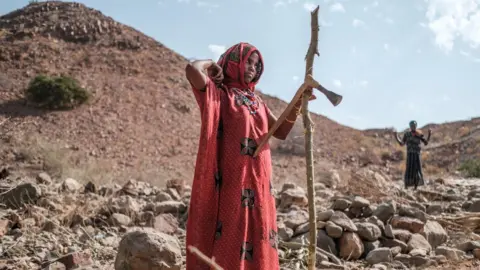
By Kalkidan Yibeltal and Phelan ChatterjeeBBC News, Addis Ababa and London

 EDUARDO SOTERASRenewed fighting may put aid deliveries at risk
EDUARDO SOTERASRenewed fighting may put aid deliveries at risk

Fierce fighting has erupted in northern Ethiopia between government and regional Tigrayan forces, breaking a five-month humanitarian truce.
The truce was agreed to allow aid to enter the region of Tigray – where thousands have died in a brutal civil war and millions need basic supplies.
People in a nearby town told the BBC they had heard heavy weapons and seen federal army units arriving.
Both sides have blamed each other for the resurgence in fighting.
On Wednesday morning, Getachew Reda, an adviser to the Tigrayan leader, said Ethiopian forces were responsible for launching an offensive against Tigray after a “week-long provocation” in the neighbouring Amhara region.
The government later accused Tigrayan forces of breaking the truce – and said federal army and security forces were responding to their attacks “successfully”.
Ethiopian officials also said their forces had shot down a plane carrying weapons for Tigray’s military, which Mr Getachew denied.
UN chief António Guterres said he was deeply shocked by the fighting and called for an “immediate cessation of hostilities”.
A man in Kobo, some 25km (15 miles) from areas where fighting has been reported, told the BBC he first heard gunfire starting on Tuesday night.
“At around 5am, the gunshots increased from both sides and we were hearing heavy weapons being fired,” he said.
The Tigray war broke out in Ethiopia’s northernmost region in November 2020 – later spreading south to the Amhara and Afar regions.
Thousands were killed, over two million people fled their homes and some 700,000 people were left living in “famine-like conditions”, US officials said.
The region has been cut off from the internet and telephone since the conflict began, making it hard to find out exactly what is happening, and difficult for people to carry on with their basic activities, including banking.
The Ethiopian government was accused of imposing a blockade on the region which impeded crucial aid deliveries – something it blamed on the fighting.
The humanitarian ceasefire reached in March 2022 went some way to increasing of the amount of aid reaching the region – but not enough.
Last week, the World Food Programme said that almost half of Tigray’s 5.5m population were in “severe” need of food.
“Hunger has deepened, rates of malnutrition have skyrocketed, and the situation is set to worsen as people enter peak hunger season until this year’s harvest in October,” the report said.
The truce raised hopes of peace talks between the two sides.
Now that fighting has resumed, relief agencies may again find it difficult to reach the millions in need, and any political negotiations will be further delayed.
Additional reporting by Hanna Temuari






GIPHY App Key not set. Please check settings